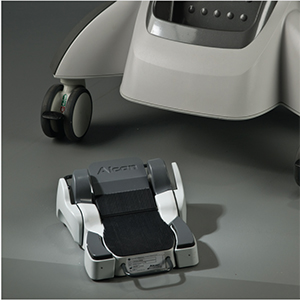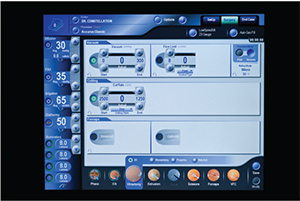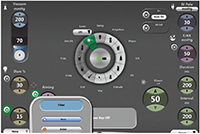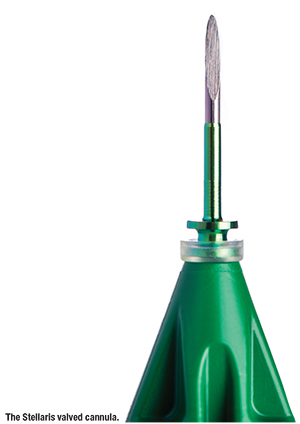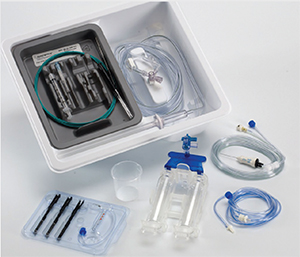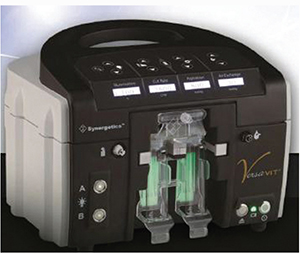| ABOUT THE AUTHORS |
 Dr. Shah is a vitreoretinal specialist and fellowship co-director at The Retina Institute, St. Louis. |
 Dr. Ho is a surgical vitreoretinal fellow at The Retina Institute. He will be joining New Jersey Retina upon completion of his fellowship. |
| DISCLOSURES: Dr. Shah is a consultant for DORC and was the first vitreoretinal surgeon in the United States to obtain an EVA system. Dr. Ho has no financial disclosures. |
 | View the Videos |
The Enhancing Visual Acuity (EVA, DORC) vitrectomy system has been designed with the highest cut rate available and utilizes an enhanced fluidics system for vacuum or flow vitrectomy modes. Here, we report on our experience with the EVA system in the surgical suite and evaluate its performance based on previous systems we have worked with. In accompanying sidebars, other retina specialists share their experiences with the other vitrectomy systems.
EVA features customizable settings, an intuitive touch screen and programmable foot switches for both vitrector and laser pedals.
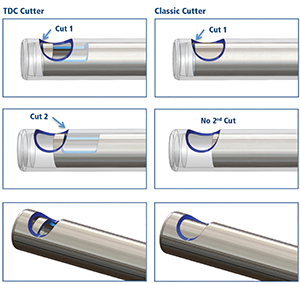 |
| Figure 1. Comparison of the DORC two-dimensional cutter vs. conventional vitreous cutter. Vitreous enters the inner aperture and is cut in a forward and then backward motion, increasing the amount of cutting in a single motion. |
Two-Dimensional Cutting
EVA utilizes two-dimensional cutting (TDC) in the 23-, 25- and 27-gauge platforms (20-gauge is available without TDC), cutting in a forward and backward motion to produce 16,000 cuts per minute (cpm) (Figure 1). While other vitrectomy systems allow surgeons to adjust duty-cycle for port-biased open (core vitrectomy mode) and port-biased closed positions (proportional vacuum/shave mode), the EVA TDC cutters produce a constant duty cycle of 92 percent biased-open position and maintain aspiration even when the blade is in the “closed” position.
The enlarged inner tube aperture of the cutter permits a steady flow rate independent of cutting speed without vacuum buildup in the tubing (Figure 2). This means minimal surge turbulence at the port and traction on surrounding tissue, particularly during flow vitrectomy mode.
Vacuum Flow Vitrectomy
The VacuFlow Valve Timing intelligence (VTi) fluidics system combines aspects of traditional venturi and peristaltic pump-based systems while overcoming some of their shortcomings to enhance fluidics inside the eye. In traditional venturi-based pumps, the surgeon controls the vacuum and flow follows the vacuum. When a pocket of balanced salt solution is encountered, flow can rapidly increase and lead to iatrogenic retinal breaks because this system depends on the viscosity of the fluid and resistance in the tubing.1,2
On the other hand, traditional peristaltic-based pumps can produce a flow-control system that is independent of fluid viscosity and removes a preset cubic centimeters per minute (cc/min) from the eye, creating a more stable working environment. However, mild flow fluctuations can occur from rotary compression of the flexible tubing.
| Constellation: All Functions Integrated By R. Ross Lakhanpal, MD, FACS The Alcon Constellation vitrectomy system represents a significant upgrade over the previous-generation ACCURUS. I’ve had the Constellation for about four years now. One of the features I like best about is how it integrates all vitrectomy functions. Here, I share my experience with the Constellation. Recent Upgrades: The Constellation has a dual-pneumatic cutter with both opening and closing mechanisms instead of the old-style cutter with pneumatic and spring mechanisms. Cut Rate: The Ultravit vitrectomy probes can achieve up to 7,500 cuts per minute (cpm) in the 23-, 25- and 27-gauge probes. That’s basically triple the maximum cut rate of the ACCURUS. You can also control the duty cycle of the probe with the foot pedal, so there’s no need to rely on a surgical tech or assistant for that. It also has a momentary setting that is helpful when you’re dealing with retained lens material.
Pump and Fluidics: The Constellation uses a venturi pump system. The dual-pneumatic cutter allows for better control of the cut rates and higher cut rates. You can modify the duty cycle to control flow independent of vacuum and cut rate, and you can select three different duty-cycle options at any given cut rate; port-biased open; 50/50; or port-biased closed. This represents significant improvements over the ACCURUS in that at 2,500 cpm the port is only open 30 to 40 percent of the cutting time. Illumination: The Constellation uses a xenon light source. The halogen light source of the Constellation provided limited visibility. The xenon light utilizes a mirror system technology that allows for co-illumination that focuses all lights into the ports without a beam splitter. Bulb life is longer and the improved fiber optics allow for improved illumination even though lumen size is smaller than the older 20-gauge systems. I was initially skeptical that 27-gauge illumination would provide adequate lighting for fine macular peeling or vitreous base dissection, but I have been pleasantly surprised. An ancillary 25-gauge chandelier system enables bimanual surgery. Instrumentation: The Constellation has an armamentarium of instruments for all gauges—forceps, picks, scissors, etc. The newer- generation 25- and 27-gauge instruments are very stiff. The initial 25-gauge instrumentation had some flexibility concerns, but they have been corrected. Other Features: The interface provides a user-friendly, customizable pop-up menu. It is all on one screen so your surgical technician does not have to scroll through multiple screens to find the settings you need. The machine integrates all your settings—intraocular pressure (IOP) control, gas, fluid-to-air, laser. The first menu shows the types of procedures the surgeon does and you select it. I only do 25- or 27-gauge surgery, so the interface brings up all the settings I prefer. No time is wasted in the setup. The ACCURUS system utilizes gravity as fluidics control with an IV pole or vented gas-forced infusion to control IOP. In this system, pressure is a static condition. The IOP control of the Constellation automatically adjusts for the infusion tubing and pressure drop when fluid flows through the cannula by measuring and checking the infusion cannula and tubing resistance during priming. The IOP control feature uses a noninvasive flow sensor that is part of the Constellation cassette and allows it to regulate IOP within ± 2 mmHg throughout surgery, an advantage over using one IOP setting. The surgeon can also control IOP with the foot pedal to control bleeding during surgery. The foot switch has many integrated features with toggle switches on either side. You can switch to fluid-air exchange, change IOP or duty cycle and go from core to shave mode. The valved cannulas also provide more control in a closed environment. This extra control can be especially important when using profluoropropane for detached retina, which does not allow for dispersion of droplets. C3F8 and SF6 gas tanks are mounted to the system. An “Auto Gas Fill” pack mixes and delivers gas at the desired percentage, allowing you to obtain gas from the machine rather than having an assistant administer it. This can also help control costs; you do not need to deal with different vendors and purchase ancillary supplies. Dr. Lakhanpal is managing partner, Eye Consultants of Maryland in Owings Mills and principal of the Timonium Surgery Center. |
The VTi aspiration system in EVA combines a series of sensitive computer-controlled operating pistons and closure valves working in small-flow chambers to allow the surgeon to function in vacuum-control or flow-control settings at the touch of a button. In vacuum mode, EVA generates a rise time up to 300 milliseconds and a maximum vacuum of 680 mmHg, both exceeding current vitrectomy systems, This allows for rapid tissue/fluid removal and powerful aspiration.
We have used vacuum mode for the core vitrectomy and maneuvers like hyaloid or membrane elevation. (Online Video 1: Vacuum Vitrectomy Mode at http://goo.gl/yygW9c) For retinal detachments, we are still careful when working near mobile retina in vacuum mode, but the 16,000-cpm, 92 percent duty cycle and absence of oscillations associated with standard rotary peristaltic systems increases fluidic stability with less turbulence and without vacuum buildup near the vitrector port.
Using Flow Mode
In flow mode, the surgeon has increased control and predictable fluid/tissue removal at increased aspiration flow rates up to three times faster than other vitrectors at higher cut rates.
The surgeon sets the flow rate coming through the port based on cc/min, and the machine automatically adapts parameters such as vacuum and infusion to maintain consistent flow regardless of whether you are in vitreous, fluid or air. (Online Video 2: Flow Vitrectomy Mode at http://goo.gl/HpVzeT)
In our experience, we created preset, programmed flow vitrectomy settings for 10, 6, 3 or 1 cc/min and cycle through these settings (with the touch screen or foot pedal). The flow setting of 10 cc/min can still efficiently complete hyaloid elevation and core vitrectomy, but improves safety by decreasing peripheral traction and iatrogenic retinal breaks. We mainly use 10-cc/min flow as the workhorse for peripheral shaving, cutting over mobile retina or removing tissue directly over the retina. For even greater control, we will use flow settings of 6, 3 or even 1 cc/min where we can nearly touch the retina while removing vitreous.
EVA also uses vented gas-forced infusion through Automatic Infusion Compensation (AIC) to create a stable surgical environment. At a specified intraocular pressure, the AIC progressively elevates the pressure settings as the aspiration of the vitrector increases. During high-vacuum vitrectomy, the AIC generates a bottle pressure above the set point so the volume of fluid removed from the eye will not exceed the volume of fluid flowing into the eye. Once aspiration ends, the bottle pressure automatically lowers the IOP back to the set point.
AIC prevents eye wall collapse and is adjustable on the touchscreen or foot pedal. For patients with low ocular perfusion pressure, we will decrease the upper limit of AIC control until pulsations of the central retinal artery resolve. Flow can also be enhanced via optional large lumen, high-flow infusion lines attached to DORC cannulas after the valve is manually removed. We mainly use high-flow infusion lines during 27-gauge surgery because flow is directly proportional to radius to the fourth power (Poiseuille’s Law) and the opening of a standard 27-gauge infusion line is small.
LED Illumination
EVA uses light-emitting diodes (LED) LEDStar Illumination, which provides up to 40 lumens without degradation of light output. LED bulbs can last more than 10,000 hours vs. about 400 hours for xenon bulbs. The high-intensity LED illumination is particularly advantageous with smaller-gauge vitrectomy because it compensates for reduced transmission through smaller probes. It is safe without ultraviolet or infrared toxicity, and the system includes integrated 435- and 680-nm filters.
EVA includes three separate LED light ports to accommodate use of chandelier lighting systems. Also, light probes are available in four configurations—shielded vs. unshielded and focal vs. diffuse—and include a clear scleral depressor adapter that allows the surgeon to perform external, trans-scleral illumination and simultaneous depression for peripheral shaving. This maneuver is simple and safe but visualization can be decreased in heavily pigmented eyes.
MVR Style One-Step Cannula
The updated one-step cannula system features a microvitreoretinal stiletto-style blade that requires less piercing force upon entry than previous trocar-cannulas (Figure 3). The slit incision allows for sutureless vitrectomy with small-gauge surgery. The translucent, removable valved cannulas provide enhanced visibility when inserting instruments and maintain a closed surgical globe with constant IOP .
A broad range of small-gauge ancillary instrumentation is available, including small-gauge peeling forceps. For membrane peels, we often use a hybrid cannula system consisting of a 27-gauge infusion port and cannula for the nondominant hand, 23-gauge cannula for the dominant hand and 27-gauge, two-dimensional cutting vitrector. (Online Video 3: Hybrid Membrane Peel at http://goo.gl/iZixQt) This allows us to use 23-gauge forceps with a greater surface area and instrument rigidity for grasping membranes or internal limiting membrane.
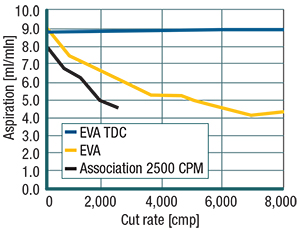 |
| Figure 2. Aspiration flow rates at varying cut rates for 27-gauge TDC vitrectors (basic salt solution at vacuum rate of 550 mmHg). DORC small-gauge TDC cutters maintain constant flow rates independent of cuts per minute. |
Control, Customization
The graphical user interface features a 19-inch touch screen, voice feedback, infrared remote control and five language choices, including English and Spanish. It displays functions on the left side of the screen. We have preset and customized settings, which we can modify and save intraoperatively, such as a scleral depression mode that lowers the IOP to a desired level.
The dual-linear, wireless vitrectomy pedal includes eight switches and two yaw directions. We use the pedal to toggle through different functions. A wireless laser pedal is also available with power adjustment switches. The 532-nm laser can be integrated into the EVA unit as an option, and adapters make EVA compatible with a wide range of laser probe brands.
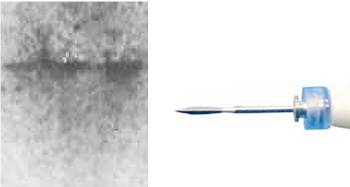 |
| Figure 3. The one-step cannula system produces slit incisions and requires less mean piercing force than previous systems. |
Other Features and Techniques
EVA also includes broad instrumentation in different gauges including myopic forceps and back-flush tools with shafts 5 mm longer than other tools. EVA can perform anterior segment phacoemulsification; but for the posterior segment, DORC manufactures a 23-gauge fragmatome.
In many cases, we have found the 23- and even 27-gauge TDC cutters can efficiently remove nuclear and retained cortical lens fragments after complicated cataract surgery. Flow mode allows for controlled purchase of lens fragments floating in the vitreous or on the retina surface. (Online Videos 4 and 5: 23- and 27-Gauge Vitrectomies for Retained Lens Fragments at http://goo.gl/ryLkHC and http://goo.gl/ZAhPh0)
We have also found that transconjunctival removal of silicone oil using the EVA and DORC viscous fluid extraction components to be safe and up to five times more efficient than other systems. The use of flow mode during air fluid exchanges prevents eye wall collapse because a preset cc/min is removed whether aspiration occurs in the fluid or air phase. (Online Video 6: 23-gauge Transconjunctival Silicone Oil Removal at http://goo.gl/9PLA42)
| Recent Upgrades Boost Stellaris PC Platform By Kevin J. Blinder, MD
The Stellaris PC phacoemulsification/vitrectomy platform from Bausch + Lomb recently underwent a few upgrades. Some of these modifications include the user interface, valved trocar-cannula entry-site alignment with modified infusion cannula, an integrated laser with wireless foot pedal and a soon-to-be released hypersonic vitrector. I’ll explain these and other features of the Stellaris PC. Recent Upgrades: In my experience, the Stellaris PC user interface seems to be simple to use and logically displayed. The central dial includes all the different functions and it is easy for the scrub tech to control and change settings. The controls are also fully programmable into the foot pedal so the you can change settings without disturbing the scrub tech or assistant. The valved trocar-cannula entry site alignment includes transparent, valved cannulas for the 23- and 25-gauge systems. The advantage of transparent valved cannulas is that you can see them retro-illuminate under the microscope illumination with the light pipe or chandelier in place, negating the need to turn on the microscope light and allowing for easier instrument exchange under dim lighting. The titanium material of the cannula has a textured feature that improves its use for wound retention. The infusion cannula has a modified tapered design that allows it to accommodate higher flow while providing for a more secure connection to the cannula. The new fully upgradeable laser module is a standard 532-nm laser that fits seamlessly into the Stellaris PC frame. The foot pedal has also been upgraded to include a safety cover for the laser firing mechanism (avoiding accidental laser activation) and dual-linear control of the laser parameters. The wireless technology allows for less clutter during the case. Cut Rate: The maximum cut-rate of the Stellaris PC is 5,000 cuts per minute (cpm). The duty cycle adjusts itself as you increase the cut rate, never going below 50 percent, thus maintaining high efficiency. The cutter has a shave mode for vitreous base trimming of mobile, detached retina, and a single-cut mode that allows you to have absolute control when dissecting retinal membranes. Pump and Fluidics: The Venturi-based pump action, based on vacuum flow, works well in the high-shave cut mode when doing a vitreous base dissection. The core settings can be used to perform vitrectomy with a lower cut rate. Illumination: The Stellaris PC has two light sources: xenon and mercury vapor. The latter, with a lower aphakic hazard profile, is suitable for longer cases with decreased risk of the prolonged light exposure leading to phototoxicity. I use the xenon light most often with three filters available to decrease the risk of phototoxicity: a green filter for membrane peeling; yellow for vitrectomy; and amber for air-fluid exchanges. B+L also recently introduced a chandelier system for the 23- and 25-gauge tools. Instrumentation: Stellaris PC accommodates instrumentation ranging from 23- to 25-gauge, with a 27-gauge to come soon. The newer 25-gauge instruments have improved rigidity, allowing for a wider range of cases. The 23-gauge fragmentation probe is a nice addition, allowing for better fluidics control. This reduces the possibility of the fragmentation aspiration out pacing the infusion, which would often occur when using a 20-gauge fragmentation needle in a 23- or 25-gauge setting. The dual-linear foot pedal allows you to control the fragmentation power along with the aspiration—a helpful feature for retained lens cases.
Other features: The soon-to-be released Hypersonic Vitrector hypersonic liquefaction function is an innovative way of efficiently removing vitreous. The new hand piece will attach to the Stellaris PC with a simple program upgrade. This could potentially change the way we think of vitrectomy and make cut rates and duty cycles obsolete. Dr. Blinder practices with The Retina Institute, St. Louis, and is professor of clinical ophthalmology and visual sciences at Washington University, St. Louis. Disclosure: Dr. Blinder is a consultant to Bausch + Lomb, Synergetics and DORC. |
REFERENCES
1. Stalmans PW. Peristaltic Pumps are better than venturi: Fact. Presentation at American Academy of Ophthalmology Retina Subspecialty Day; October 17, 2014; Chicago, IL.
2. Ducournau D, Warren KA, Stalmans P, et al. EVA: A state-of-the-art surgical system for phaco-vitrectomy. Retina Today (suppl). May/June 2013.
| VersaVit 2.0: Portable, Economical By Derek Kunimoto, MD The VersaVit 2.0 vitrectomy system from Synergetics has carved its niche as the small, portable vitrectomy platform. As such, it does not have all the features and options of larger platforms, but it is a versatile unit if your practice demands economy and portability. Here are my impressions of the VersaVit 2.0.
Recent Upgrades: Recent improvements to the VersaVIT 2.0 include the addition of an automated reflux feature, viscous fluid tubing and tips for 23- and 25-gauge silicone oil infusion and extrusion, improved trocars with fewer problems of slippage during surgery and an increase in vacuum pressure to more than 600 mmHg. Cut Rate: VersaVIT 2.0 provides linear control of cut rate to a maximum cut rate of 6,000 cuts per minute (cpm), adjustable in 500 cpm increments from 2,500–6,000 cpm. Below 2,500 cpm, adjustments to maximum cut rates can be made in increments of 200–600 cpm. VersaVIT 2.0 allows for three duty-cycle options. The cutter can be biased-open for maximum efficiency during core vitrectomy, neutral (50 percent open/50 percent closed) or biased-closed for maximum safety when working close to the retina. Pump and Fluidics: A micro-diaphragm pump allows for vacuum levels above 600 mm Hg. The micro-diaphragm reacts quickly to the surgeon’s foot pedal control when increasing or decreasing vacuum. This provides excellent control over both vacuum and flow.
Illumination: An embedded dual port light-emitting diode (LED) source provides excellent lighting and filters light at very safe levels. I have never had a case where the illumination was inadequate with the VersaVIT 2.0. The advantage of LED lighting is its longevity, which may even outlast the life of the machine. There is also an option for adding a Photon EX, which is a dual-port xenon-based light source for powering smaller illumination products. Instrumentation: A full line of instrumentation is available with the VersaVIT platform. The vitrectomy packs are currently available in 23- and 25-gauge. The 27- and 20-gauge packs are planned for release in the second quarter this year. The instruments are simple, straightforward and user-friendly. Boot-up time is less than 30 seconds, a nice advantage for setup. I consider the VersaVIT 2.0 as the Apple of vitrectomy platforms, with a sleek and minimal interface. Each button is designed to have a specific and necessary function. Other Features: VersaVIT 2.0 can handle the most complex retinal detachments to the straightforward macular pucker cases. While it does not have a fragmatome, it does have a bigmouth vitrectomy probe to allow removal of mild to moderate nuclear sclerosis. Nor does it have a built-in laser, but a separate laser module can be added. However, the VersaVIT 2.0 is the most economical of vitrectomy platforms to acquire, and pack prices are competitive. It also is portable, with a small footprint. This platform is well-suited for those who need to move their vitrectomy unit often or have limited space. Dr. Kunimoto practices with Retinal Consultants of Arizona in Phoenix. |
